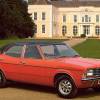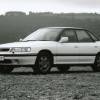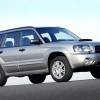
RAC sale – up to 33% off*
• Roadside cover from £5.29 a month†
• We get to most breakdowns in 60 mins or less
• Our patrols fix 4/5 breakdowns on the spot

BY ANDY ENRIGHT
Introduction
Rather than bask in its reflected glory. The Subaru Legacy has been rather overshadowed by the success of its junior sibling, the Impreza. Conjuring up images of green wellies and countryside vets, the Legacy's all-wheel driven dynamic excellence has largely been ignored as buyers opt for smaller offerings from Germany or Sweden. Nevertheless, the big Subaru's legendary reliability and rugged mechanicals make a surprisingly beguiling used prospect. A lasting Legacy? They don't build them any other way.
Models
Models Covered:
(4dr saloon/5dr estate 3.0, 2.0, 2.5 petrol [GL, GX, Outback])
History
The Legacy's been with us since 1989, and in its earlier days it was arguably a higher profile model than it is now, with the 4-Cam Turbo cars scoring rally wins and garnering a small cult following. 1994 saw the introduction of a restyled car, boasting chunkier styling and better interior quality, as well as the launch of the 'soft-roading' Outback series. The third generation range arrived late in 1998 with a choice of GX and Outback 2.5-litre estates, although first UK registrations will be 1999 model year. For a year or so for budget buyers, Subaru UK continued to import the old-shape 2.0-litre Estate model (built in the US), badged as the Classic in LX and plusher GL forms. In March 1999, a new third generation 2.5-litre GX saloon was added to the range. Late in 1999, the third-generation entry-level two-litre GL saloon and estate were introduced and the old-shape Classic models were finally dropped. In October 2000, a top H6-3.0-litre version of the Outback was introduced as the range's flagship.
Summer 2001 saw a series of revisions to the Legacy and Outback estates, the most noticeable being the rather strange headlamps with Subaru call 'double deck', more substantial front and rear bumpers and that staple of facelift targets, the front grille.
All models had their interiors revised, with extra comfort built into the seats, and whole forests of plastic wood smeared across the fascia. The instrument panels were made clearer and the ignition barrel illuminated in one of those thoughtful touches all car manufacturers should employ. The boomerang-arm rear suspension system continued much as before, but the chassis subframes were beefed up to provide better structural rigidity and some state of the art shock absorbers with multi-layer valves were employed up front to adjust the level of damping force according to the car's speed. In late 2003 an all-new Legacy range was unveiled. The slightly awkward styling and uninspired interior design of its predecessor were consigned to the history books and some interesting engine choices were offered. In Summer 2004 a range-topping 3.0R spec.B was announced. It slotted in above the existing automatic 3.0R offering a manual gearbox and some specification upgrades.
What You Get
Whichever Legacy you choose, you'll find it equipped with either a flat-four boxer engine whose gruff, if rather ragged, note is curiously endearing or a powerful flat-six. Whilst neither of the four-cylinder units on offer were really new, both were heavily reworked to make them more frugal and to provide greater low-down pulling power. There are also marginal improvements in ultimate speed - though not in refinement. The all-new 3.0-litre 209bhp six cylinder boxer engine addresses this somewhat, although the Outback estate variant it's plumbed into can't really compete off-road against the Audi allroad and Volvo V70 Cross Country.
Marginal is also the right word to describe the exterior changes, even though the third generation body is described as "totally new". There are larger headlamps and a bigger front grille. At the rear, the full-width reflector has grown and the back window of the estate drops down into a subtle V-shape.
For reasons best known to the importers the excellent VDC stability control system is an optional feature that can be ordered only on 2.5-litre Legacy models - and then only if you order them with automatic transmission and a 'Luxury Pack'. As you'd expect however, it's standard on the flagship H6-3.0 model. The standard choice is between the entry-level 2.0-litre GL saloon and estate, the well-equipped 2.5-litre GX variants or the wilder estate-only 2.5-litre Outback model with its raised suspension, bigger foglamps, fatter tyres, side skirts and lower body cladding.
Whichever version you choose, you'll find ABS, twin front and side airbags, all-round electric windows, an anti-theft immobiliser remote, an outside temperature gauge, infra-red remote control central locking and, of course, four-wheel drive. Opt for a 2.5-litre model and you can also expect alloy wheels and leather covering for the steering wheel, gear knob and handbrake lever. All of which is a long-winded way of saying that yes, the latest Legacy is indeed plusher than before. And bigger. In the estate, re-engineering the rear suspension has seen the springs shrink under the floor to allow for a wider, flatter load bay and 58.1cuft of storage space with the seats folded. Otherwise, the interior is much as before, though the acres of plastic have now been broken by mock-wood fittings in plusher versions, a Mercedes-like auto-gear selector gate, and the flimsiest cup holder this road tester has ever encountered.
What You Pay
Please fill in the form here for an exact up-to-date information.
What to Look For
The Subaru Legacy regularly finishes near the top of the pile when the JD Power results roll round, but it pays to know what to look out for. Perhaps because the Legacy is most often associated with its estate guise, it is this body shape that sells on most easily. When buyers look at a Legacy saloon, they tend to become temporarily puzzled before making a beeline for a Volvo/Audi/BMW dealer. The flat-four engine has existed in one form or another for many years now. That's good news, as it's well proven and has had many updates over the years so don't be put off a Legacy just because it's a bit different under the bonnet. Corrosion is notable by its absence, as are electronic gremlins. Japanese reliability is second to none and the Legacy is typical. Do check the driveshaft 'boots' for wear on the more powerful cars - cornering on full lock will have them making awful noises if damaged. Check the interior fixtures and fittings. One problem area that Legacy owners have highlighted is the durability of interior trim. The plastic quality has got better over time, but some of the fittings are quite flimsy.
Replacement Parts
(Based on a 2000 Legacy 2.0 GLS and exclusive of VAT) A clutch assembly will set you back about £200 and a new exhaust about £150 excluding catalyst. Front shock absorbers are close to £130 each. An exchange alternator comes in at around £300 and an exchange starter motor at around £150. A new radiator is about £215. Replacement door mirrors are around the £150 mark and a headlamp about £140.
On the Road
If you're unsure about a Legacy, take the opportunity for a test drive in, say, a 2.5-litre estate and prepare to be amazed at how much fun it is. Beneath that conservative body lies a car built by people who care about driving. The 2.5-litre normally aspirated flat four offers a good compromise between power and parsimony, and it's got real character. It encourages press-on driving, its presence heard above 3500rpm, becoming a blaring throb towards the top of the rev range. The automatic gearbox slurs changes smoothly, but is prone to some hunting during part opening of the heavy throttle pedal. Ride quality is superb, with the revised 'boomerang-arm' rear suspension giving an admirable ride/handling compromise for such a hefty vehicle. The steering feels lively, if slightly overassisted at lower speeds, but gives better feedback as the assistance reduces with speed. It's at speed, and into a set of streaming wet bends, that the Legacy excels. Subaru have been unable to resist engineering some fun into the car, and with a 35/65 per cent torque split, it feels like a rear wheel drive car without the drama. The Vehicle Dynamic Control system that is part of the luxury pack adds to the car's capabilities to such an extent that it should really be standard equipment.
Barrelling into a corner at manifestly overoptimistic speeds, the yellow VDC light will blink on the dashboard and the revs will dip slightly, the brakes busily nipping and skimming at each disc in turn. The brakes are excellent, visibility is admirable, load space is somewhere between a BMW/Audi and a Volvo/Passat, and the multi-link adjustable suspension and rugged four-wheel drive hardware contrive to give the Legacy a reassuringly bulletproof feel.
Overall
Subaru aimed upmarket with the Legacy and pretty much missed the mark. Due more to the rise of the 'lifestyle' estate rather than any inherent deficiency on the part of the Legacy, this makes the big Subaru look even better value as a used buy. Unfortunately, the high level of customer satisfaction means that present owners seem unwilling to part with them. Finding one in your preferred body style, trim and colour combination may not be easy but it'll make a faithful, if quirky, companion. If you think that all modern cars are pretty much the same, a drive in a nearly new Legacy may give you cause to reconsider.







